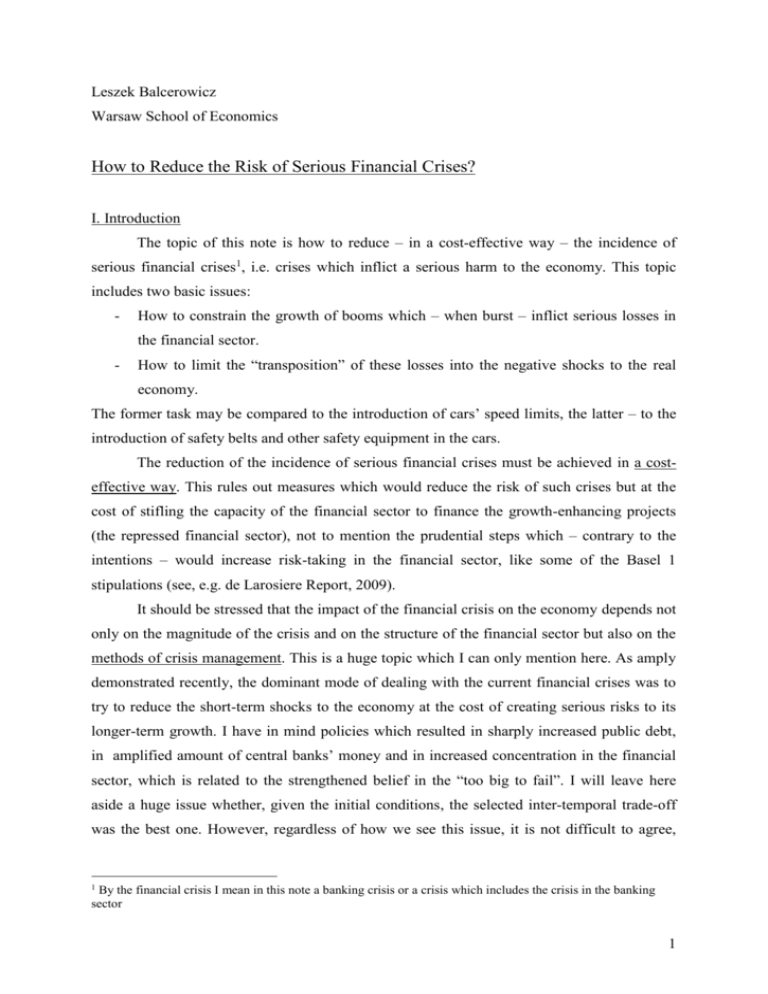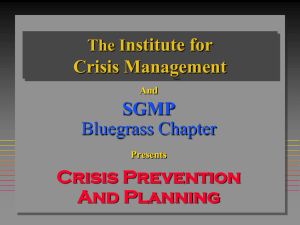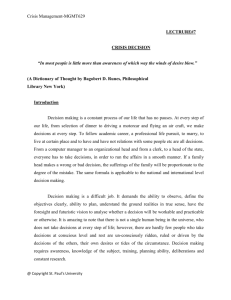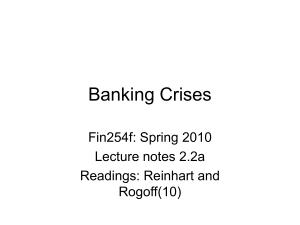Leszek Balcerowicz
advertisement

Leszek Balcerowicz Warsaw School of Economics How to Reduce the Risk of Serious Financial Crises? I. Introduction The topic of this note is how to reduce – in a cost-effective way – the incidence of serious financial crises1, i.e. crises which inflict a serious harm to the economy. This topic includes two basic issues: - How to constrain the growth of booms which – when burst – inflict serious losses in the financial sector. - How to limit the “transposition” of these losses into the negative shocks to the real economy. The former task may be compared to the introduction of cars’ speed limits, the latter – to the introduction of safety belts and other safety equipment in the cars. The reduction of the incidence of serious financial crises must be achieved in a costeffective way. This rules out measures which would reduce the risk of such crises but at the cost of stifling the capacity of the financial sector to finance the growth-enhancing projects (the repressed financial sector), not to mention the prudential steps which – contrary to the intentions – would increase risk-taking in the financial sector, like some of the Basel 1 stipulations (see, e.g. de Larosiere Report, 2009). It should be stressed that the impact of the financial crisis on the economy depends not only on the magnitude of the crisis and on the structure of the financial sector but also on the methods of crisis management. This is a huge topic which I can only mention here. As amply demonstrated recently, the dominant mode of dealing with the current financial crises was to try to reduce the short-term shocks to the economy at the cost of creating serious risks to its longer-term growth. I have in mind policies which resulted in sharply increased public debt, in amplified amount of central banks’ money and in increased concentration in the financial sector, which is related to the strengthened belief in the “too big to fail”. I will leave here aside a huge issue whether, given the initial conditions, the selected inter-temporal trade-off was the best one. However, regardless of how we see this issue, it is not difficult to agree, 1 By the financial crisis I mean in this note a banking crisis or a crisis which includes the crisis in the banking sector 1 given the indicated exit problems, that it is worth searching for ways which would limit the incidence of serious financial crises. In searching for such measures we should go beyond the current global financial crisis and avoid focusing á priori on just one kind of preventing steps, e.g. the financial regulations. Such a narrow approach can eliminate from the investigation some important causes of the financial crises and may, thus, lead to incorrect (i.e. counterproductive non-productive or cost-ineffective) remedies. Instead, one should take a widest possible view of the incidence of the financial crises and – using the available empirical research – link the variation in their frequency to the likely causes. II. The dominant view of the financial crises versus the empirical research. The dominant theoretical view of the financial sector stresses: 1. the fragility of banks, resulting from the liquidity transformation they perform, from the insufficient risk monitoring effort by the individual banks, due to the fact that the private benefits from this activity are less then the social ones, and from the information asymmetries between banks’ stakeholders and the bank management. 2. the “procyclicality” of the financial sector in the sense of the operation of a positive feedbacks which amplifies the initial growth of the activity of that sector and, thus, leads to self-amplifying (“endogenous”) booms. In the extremis, one concludes that the only stop to this self –amplification is the financial crisis. This mainstream theoretical view of the banks and of the financial sector is complemented by the widespread interpretation of the influential historical accounts (e.g. Kindleberger, 1978) which stress the recurrence of financial crises for at least the last 300 years of capitalism (if not earlier) and ascribe it to the psychological propensities of the investors (“manias”, “animal spirits”, etc). Both the theoretical and historical analyses, create a widely shared impression that the financial instability is the constant feature of the financial sector due to some interactions of the inherent characteristics of the banks and of the financial sectors (often qualified as “market failures”) and of certain psychological propensities of the financial investors. This dominant view crowds out a fundamental empirical question of what have been the differences in the incidence of serious financial crises and their causes. It also creates the presumption of public intervention (regulation) as the only available means to reduce the risk of financial instability, given the assumed inherent features of the banks and of the financial sector and/or the suggested psychological propensities. 2 Calamiris who criticized the dominant theoretical and historical views shows in a pathbreaking paper (2009a) that the incidence of the banking crises has sharply differed across countries and time. In this situation, just stressing the invariant recurrence of the serious financial crises and disregarding the differences in their frequency may be compared to emphasizing the “invariant” fact that cars cause accidents and disregard how frequently they occur, depending on the construction of the cars and on the conditions under which they are driven. Furthermore, market failures usually refer to the cases when the real-life situations fall short of a certain ideal (e.g. private costs and benefits equal the social costs and benefits). However, as it is widely known, to identify such a deviation is not enough to demand the public intervention. In addition, it must be shown that there are cost-effective ways of reducing the market failure. And some “deviating” situations classified as “market failures” – may result from certain public interventions. This appears to be the case with respect to the financial crises (see sect. II). In his review of empirical research on banking crises Calomiris (2009) presents five illuminating comparisons: 1. During the pre-Word I period the banking crises were – in general – much less frequent and costly compared with the past 30 years, when 140 episodes have been documented in which banking systems experienced losses in excess of 1% GDP, more than 20 episodes resulted in losses in excess of 10% GDP, and more than half of which resulted in losses in excess of 20% of GDP (p. 35) 2. During the pre- I World period Argentina, Australia, Norway and Italy suffered especially severe banking crises which resulted in the banking losses between 1 and 10% of GDP. “All of them suffered real estate boom and bust (…), and prior to theses crises all of them had employed unusually large governments subsidies for real estate taking that were designed to thwart market discipline” (p. 97) 3. During the same period the US suffered much more frequent banking crises than Canada even though both had the same monetary system and neither of them had the central bank. The higher incidence of banking crises in the US is ascribed to the ban on private risk diversification (unit banks) while branching was allowed in Canada (p. 32-34). 4. The US’s history shows that some forms of public intervention lead to especially severe banking losses. In the 1830s, states that directed the credit of their banks faired particularly badly (Schweikart, 1987, quoted after Calomiris, 2009 b). (The destructive role of political interference in the credit allocation has been also found in modern times). Prior to both the bank failure waves of the 1880s. and the 1920s, “some states enacted systems of deposit 3 insurance in which neither entry nor risk taking was effectively constrained. These states experienced far worse banking system failure rate and insolvency severity of failed banks than did other states” (Calomiris, 2009 b, p. 12). This suggests that uninsured depositors can act as a source of market discipline, and that generous deposit insurance enhances the propensity of the banks to take risks and can, therefore, contribute to their instability (For more on this see: Kaufman, 1996; Barth et al, 2006). However, such an insurance has spread around the world, starting by the US in the 1934. 5. “Britain experienced major panics in 1825, 1836-39, 1847 and 1866, but then the propensity for panics ended for over a century” (Calomiris, 2009b, p. 41). Empirical research, indicates that this transformation was brought about by changes in Bank of England policies. Prior to 1858 it accepted “a virtually unlimited amount of paper for discount at a uniform rate”, both in the bubble phases – which fuelled their growth, and in their aftermath. Starting in 1985 the Bank had made its discounting policies much less generous, and during the crisis of 1866 it refrained from assisting a major bank which made its no-bail-out policy credible. This example shows that the present discussion on the proper role of the central bank with respect to the financial (in) stability has some interesting antecedents. It also suggests that the primary topic for this debate is not how the central banks should prevent the asset bubbles and the resulting financial crises but how to prevent them from occasionally fuelling these bubbles and then from the successive mitigating interventions which accumulate the moral hazard in the financial sector These finding as well as the empirical research on the modern financial crises (see eg. Calomiris, 2009a, Barth at al, 2006) strongly suggest that the differences in the frequency of serious financial instability can not be credibly linked to some constant features of the banks, the banking sector and of human nature. Instead one should focus on the public policies which shape: 1. the structure of the financial institutions and of the financial sector, 2. the institutional, regulatory and macroeconomic environment within which they operate. One should identify those factors which: 1) Enhance the risk-taking in the financial sector by crowding-out the market discipline and/or by subsidizing the risk-taking by the decision-makers in that sector and/or by the borrowers. 2. Enhance the credit and asset booms. 4 III. Policies which contribute to financial crises My reading of the empirical literature on the causes of the financial crises (including that on the recent one) leads me to the following - certainly incomplete - list of policies; which contribute to the financial crises: 1. Politicized (or state-directed) credit allocation: it is usually driven by political considerations which dominate the economic risk assessment and, thus, leads to large banking losses and/or to Sovereign debt distress. The activity of Fannie May and Freddie Mac in the US is the recent example. 2. Persistently expansionary fiscal policy: it contributes to spending booms and may also result in the banking losses and in the public debt problems. 3. Monetary policy which occasionally leans “with the wind”, i.e. fuels asset bubbles (Fed’s policy in the 2000’s being the main recent example). It has been linked to a doctrine of monetary policy which narrows its goal to the short-term CPJ inflation, and excludes from its purview asset price developments and the related factors (e.g. the growth of monetary and credit aggregates). 4. Tax regulations which favour debt financing relative to equity finance. 5. Subsidies to the mortgage borrowing. 6. Financial regulations which encouraged excessive securitization, e.g. the risk-weights contained in Basel 1 and the mandatory use of credit rating by the financial investors. 7. Generous deposit insurance which eliminates an important source of market discipline. 8. Regulations which limit the shareholders concentration in large banks and thus increase the agency problems and weaken market discipline (Calomiris, 2009a). This may be an important source of the managers compensation schemes which favour short-term gains and disregard longer –term risks. 9. Policies which have resulted in the “too big to fail” syndrome, i.e. financial markets’ subsidization – vía reduced risk premiums – of the large financial conglomerates. This is another important instance of public interventions which weaken the market discipline. The resulting concentration, in the face of the financial crisis, exerts an enormous pressure upon the decision-makers to bail-out large financial companies again, thus creating a sort of a vicious circle. The policies in question included an easy acceptance of the mergers of already huge financial companies and an easy-money policy which fuelled the growth of already large financial conglomerates. 5 As the first best, such distorting policies should be eliminated. Other measures should be considered if the first – best proposals hit the political constrains, or if it can be shown that they are insufficient to ensure a cost-effective reduction in the risk of serious financial crises, and other better remedies are avoidable. IV. A look at the proposed preventive measures. A look at the huge literature on how to reduce the risk of another serious financial crisis reveals a long list of the proposed preventive measures. It appears to me that the proposals which are most frequently put forward by various official bodies are the following ones: 1. Increase the required capital in the banks and in some other financial institutions. 2. Reform the risk-weighted capital requirements, e.g. by supplementing them by a limit on the general leverage. 3. Introduce macroprudential regulations in the form of the countercyclical capital charges, dynamic provisioning or contingency capital provisions. 4. Work-out and introduce the prompt corrective action schemes (PCA) and an efficient insolvency procedure for large financial companies which would minimize the negative spillovers resulting from such an insolvency. 5. Introduce the regulations and supervision with respect to the compensation schemes in the financial institutions. 6. Identify the systemically important financial institutions and subject them the increased capital requirements and other regulatory requirements, depending on their contribution to the systemic risk. 7. Limit the risk which can be taken by the deposit-taking institution by banning them from engaging in more risky activities. This would lead to the restructuring of the present financial conglomerates and to the division of the financial companies into more or less “narrow” banks and firms which are allowed to take more risks. I am neither in a position to comment here in detail on the respective proposal nor it would be advisable in this stage of the debate. Let me instead offer four general observations: First, steps which would eliminate the policies that contribute to the financial crises are conspicuously absent on the list. This refers especially to procyclical fiscal and monetary policies, to tax regulations which favour the debt financing and mortgage credit, to the 6 generous deposit insurance, to the mandatory use of credit ratings, to the reforms in corporate governance which would strengthen the shareholders position vís a vís the managers. As a result, the issue of how to strengthen the market discipline is rather neglected. There is a continued presumption of regulation. Second, some proposals (increased capital requirements, prompt corrective action, efficient insolvency of large banks) may be, however, regarded as intended to mimick the effects of market discipline (see G.G. Kaufman, 1996). The question is whether they can work. Third, and on the related note: most proposals are still not sufficiently elaborated while the devil is, indeed, in the detail. This obviously makes it very difficult, if not impossible, to evaluate their costs and effects. The story of the unintended effects of some Basel regulations should provide a warning against a hasty introduction of not sufficiently elaborated and tested regulations. Fourth, the devils is not only in the detail of the respective proposals but also in the relationship between – the sufficiently elaborated – versions of the proposed measures. Which of them are substitutes and which are complements? For example, what is the relationship between the proposal 4 ,5 ,6 and 7? They appear to me to be substitutes but in some reports they are all on the list of the proposed measures. Or, regarding the macroprudential regulations (which I personally consider to be potentially very useful): are countercyclical regulations and contingency capital requirements substitutes, and if yes which is to be preferred? The point is not only to get sufficiently detailed version of the respective proposals but also to be able to say which of them form the best, most cost-efficient combination. We are a long way from that. V. Concluding comments. Summing up, much work remains to be done on the way to cost-effective package of measures which would reduce in the cost-effective way the risk of another serious financial crisis. The necessary steps should include the elimination of most important policies which – in the light of empirical research – have contributed to the financial crises. The respective proposal should be elaborated in a much greater detail and the relationships between them should be clarified, so that becomes possible to select the most cost-efficient combination of the preventive steps. 7 References Barth, James, Gerard Caprio, JR, and Ross Levine (2006), Rethinking the Bank Regulation: Till Angels Rule, Cambridge University Press Calomiris, Charles (2009a), Financial Innovation, Regulation and Reform, Cato Journal, No 1, 65-91 Calomiris, Charles (2009b), Banking Crises and the Rules of the Game, NBER, October Kaufman, George G., (1996), Bank Failures, Systemic Risk, and Bank Regulation, Cato Journal, Nr 1, p. 17-45 Kindleberger, Chalres (1978), Manias, Panics, and Crashes: A History of Financial Crises, New York, Basic Books De Larosiere Report, 2009, The European Commission Schweikart, Larry, (1988), Jacksonian Ideology, Currency Control, and Central Banking, The Historian, Nov., p. 78-102 Warsaw, April 2010 8







